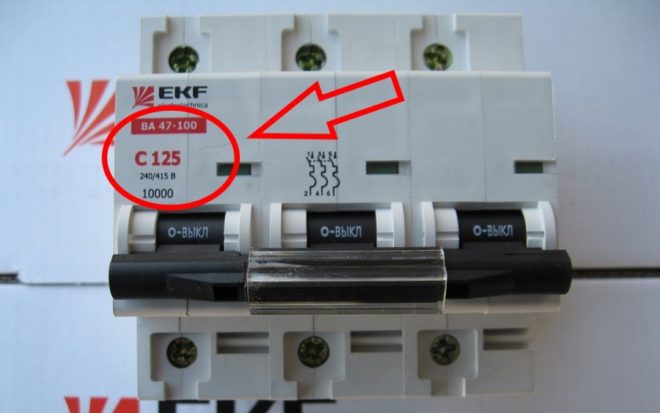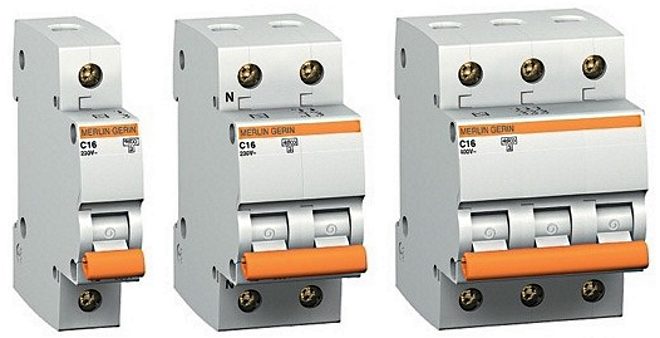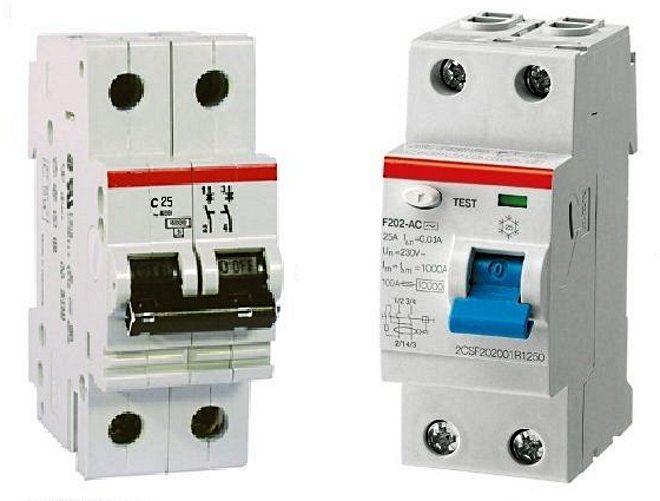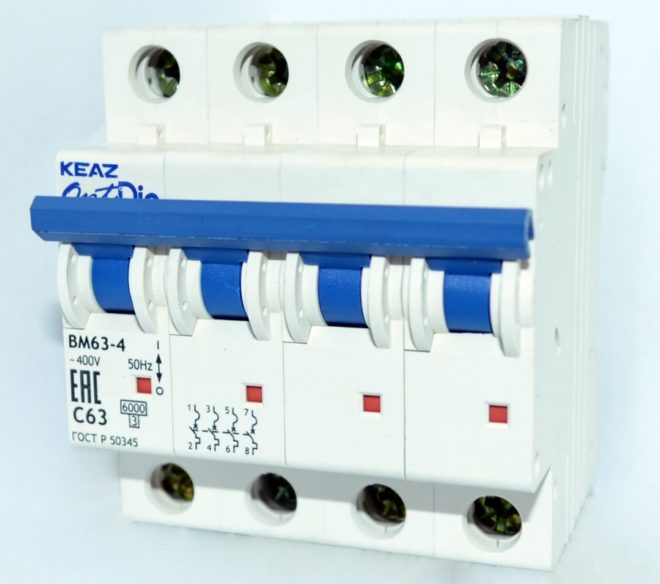Introductory machine

Internal wiring includes various elements, each of which solves its own problem. One of the most important is an introductory automatic device - a switching device installed in front of the meter, which allows you to automatically de-energize the line in an emergency, as well as if it is necessary to repair the wiring. In accordance with the requirements of the PUE, the installation of this device is mandatory, and the operation of wiring not equipped with it is not allowed. In this article, we will talk about what an introductory circuit breaker is, how to choose this device and how the input machines are calculated for a private house or apartment.
Content
Introductory circuit breaker: device types and selection features
As mentioned above, the input machines allow you to turn off the power of the wiring if it needs to be repaired or modernized. An introductory machine is usually not installed in an apartment; its installation is most often carried out on the staircase. In one-story buildings, they are installed outside the house, on the street. Outwardly, the input circuit breaker is practically indistinguishable from the protective devices mounted inside the switchboards, but at the same time the value of the rated current for which it is designed is much higher.

Protective devices installed on the input can have from two to four poles. The number of them at the selected machine depends on the power supply mechanism, the installation of which was carried out at the facility.
Sometimes a simple protective circuit breaker with a large current rating is placed at the input in front of the electric meter. The installation of this device does not provide reliable protection of the wiring, since when the power is cut off, the phase line breaks, but the neutral conductor is still in contact with the electricity supply device.
What is a circuit breaker and their varieties - in the following video:
Which machine at par to put on an apartment or a private house can be decided by calculating the total current of the conductor and power lines. Calculations must be made based on the fact that all devices are turned on, which means that the line is under maximum load.
A device should be selected whose operation in the event of a short circuit is designed to exceed the rated current by approximately 1000 A.
When choosing an input device, one should take into account the power consumed by the object, as well as the phase of the power supply. In single-phase networks, in front of the electric meter, VA must be installed on two poles, for three-phase circuits - on three or four.

The voltage to the device is supplied through an overhead or underground line.
Two-pole input machines
Installation of input devices with two poles is common in typical modern apartments. In single-phase networks, devices with a current rating of 25, 32 or 50 Amperes are most often installed in front of the electric meter. A 50 A machine is able to withstand the greatest load, but this does not mean that it is better than others - the amount of current that VA can withstand must correspond to the calculated one.
Structurally, the input device for two poles is a pair of combined single-pole devices with a common interlock, as well as with a single control lever. This is due to the fact that the requirements of the PUE prohibit breaking the neutral circuit.
Installation of two-pole circuit breakers is carried out simultaneously on the phase and zero conductors. When the VA is triggered, the power supply to the circuit is completely cut off.
When answering the frequently asked question: is it possible to install not a two-pole automatic input, but two single-pole ones - we again turn to the Electrical Installation Rules. This procedure is prohibited by the requirements of this document.

Installation of protective devices with two poles is carried out both in old residential buildings, in the wiring of which, as a rule, grounding is not provided, and in new ones. This is due to the fact that if the connection of the input machine is made by an unskilled person or an inexperienced electrician, then there is a risk of incorrect connection. If you mix up the cables, then when the protection device is turned off, it may turn out that not all the wiring in the apartment will be de-energized, but only one of its branches, which can lead to electric shock during operation.
When connecting the input two-pole, a phase is connected to it, which then goes to the meter, and after it - to the RCD. Then it is distributed to the bags. The zero cable is connected to the second pole, from it to the electric meter, and then to the residual current device of each of the wiring branches. The grounding cable, bypassing the two-pole, is connected to the PE bus, from which it goes to the devices installed in the room. If the VA is connected in this way, then its operation will occur both on the input line and on a separate branch, if the circuit breaker responsible for protecting the latter has become unusable.

Installation of an input device in three-phase networks
The three-phase network is most common in homes where cooking is done not on gas, but on electric stoves. For its protection, introductory machines with three or four poles are used. A three-pole device in case of overload or short circuit allows you to simultaneously turn off all three phases of the circuit. A separate phase wire is connected to each of its terminals. When asked whether an introductory machine is connected in a three-phase circuit before or after the meter, we answer - the VA is connected in the same way as in a single-phase network, in front of the electric meter. To prevent injury to people by electric shock as a result of leakage, it is recommended to include an RCD in the line.
What are the introductory machines for the poles and how they are used - in the following video:
Four-pole VA is used in three-phase power grids much less often than devices with three poles. They are installed, as a rule, in four-wire circuits. The main difference when connecting it from the three-pole device described above is that a neutral wire is connected to the fourth pole. Otherwise, the cables are distributed in the same way as when connecting a three-pole VA. Much more often, a 4-pole device is used for a four-phase connection, since in case of an emergency on any of the branches, it will turn off the current supply to all four.

In this case, the meter is connected, as always, after the introductory machine.
When calculating an input device for a 3-phase network, all the loads that fall on each of the current-carrying conductors should be summed up.
The operating current is calculated as follows:
- We consider how many kilowatts are in each of the phases, adding up the power of the connected devices (in kW).
- The resulting amount is multiplied by 1.52 (for a network with an operating voltage of 380 V) or by 4.55 (220 V).
- The result will show how many amperes the operating current is. The nominal value should be higher, so you need to select the machine for the closest indicator.
This is how VA is chosen in the case when an equal load is applied to each phase. If it is not the same, the current should be calculated according to the largest value.
By what parameters is the input device selected?
The choice of an introductory machine is made taking into account a number of characteristics. You need to know them in order to choose the right VA for a specific power grid:
- Maximum short-circuit current.If you are choosing a device for a summer cottage or a rural house, in most cases a breaking capacity of 4.5 MA will be sufficient. For an ordinary city apartment, a 6 MA device is suitable. If a substation is located near your machine, you should install a machine for 10 MA.
- Working current. How to calculate it - we described above. Based on the value obtained, the rated current VA is selected.
- Time-current characteristic. The most common devices are class B, C and D. Type B circuit breakers are installed if high power devices are not included in the circuit. If medium power devices (for example, a welding machine) are periodically connected to the network, a class C device is installed at the input. If high power equipment is used, the input device must be of type D.
Conclusion
In this material, we figured out whether it is necessary to put an input machine into the electrical network, what is its function, and also decided how to include the input machine in the circuit - before or after the counter. Finally, let's say that before connecting the input device, you need to check the quality of the wiring. Defective cables must be replaced.





